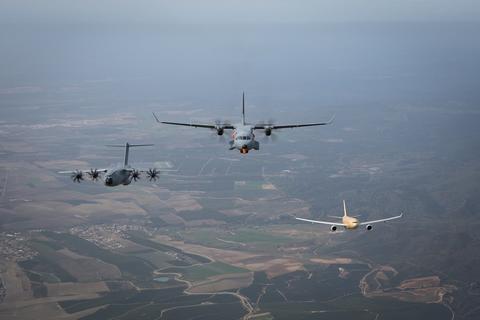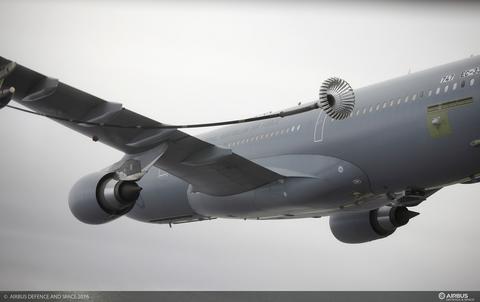Europe became a player in jet-age combat aircraft during the 1970s, when Airbus predecessor Messerschmitt-Bölkow-Blohm (MBB) joined with companies in the UK and Italy to develop the Panavia Tornado – a twin-engine, variable-sweep-wing multirole fighter.
Ultimately producing 992 aircraft, the tri-national Panavia Consortium oversaw this programme, with MBB assigned a 42.5% share of the workload and manufacturing the Tornado’s centre fuselage at its Manching facility (in then-West Germany). The front fuselage and tail assembly were built by the British partner (also with a 42.5% share, and the wings in Italy (with a 15% work share).
First flight of the Tornado occurred in August 1974 from Manching, and the aircraft was introduced into service beginning in the 1979-1980 timeframe. It was designed to replace several different aircraft types in the adopting air forces of Germany, UK and Italy; Saudi Arabia subsequently became the sole Tornado export operator.
Intended initially for the low-level strike mission, Tornado was designed with the variable-sweep wing to operate effectively at both high and low speeds. During the aircraft’s production run (which ended in 1998), the Tornado was produced in three variants: as an interdictor/strike fighter-bomber; an electronic combat/reconnaissance platform for the suppression of enemy air defences; and as an air defence variant for interceptor missions. Combat duties performed by Tornados included operations by UK Royal Air Force, Italian Air Force, and Royal Saudi Air Force during the 1991 Gulf War (flying low-altitude penetrating strike missions).
The aircraft also were flown in Yugoslavia during the Bosnian and Kosovo wars, in the Iraq War, the Libyan civil war, as well as performing duties in Afghanistan, Yemen, and Syria. The Tornado was capable of delivering a full range of air-to-ground weapons in the NATO inventory, along with air-to-air missiles. Certain Tornados deployed by the UK were configured to carry the British WE.177 nuclear bomb, while German and Italian Tornados were adapted to deploy with U.S.-made B61 nuclear bombs.
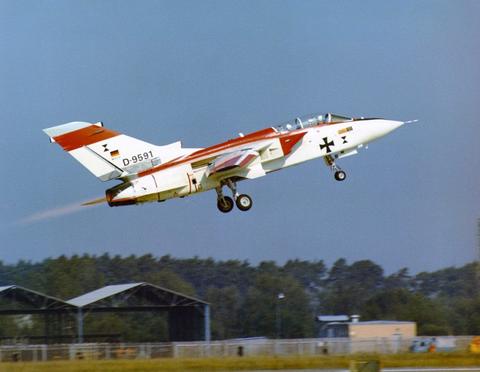
MRCA P 01. First Prototype, D-9591.
Typhoons for Europe and export
The Eurofighter Typhoon combat aircraft is the result of Europe’s largest defence collaboration programme – surpassed the combined 500,000-flight hour milestone in 2018. This twin-engine aircraft is based on the collaboration of four European nations and their aerospace/defence industries: Germany, Spain, the UK and Italy.
Airbus has the largest ownership in the industrial grouping (46%), handling its production activities at the company’s facilities in Germany and Spain.
As an advanced multi-role combat aircraft, the number of Typhoons totalled nearly 500 in service by early 2019 with the air forces of the UK, Germany, Italy, Spain, Austria, Saudi Arabia and Oman; the potential is for this figure to grow in the coming decades.
The Typhoon traces its roots to 1994, when the Chiefs of Air Staff of Germany, Spain, UK and Italy all agreed on their advanced aircraft requirements, with the versions performing their first test flights the same year. Between 2003 and 2005, the Typhoon was introduced into service across the four core nation's air forces.
Saudi Arabia became a customer in 2005 and received its first aircraft in 2008. The Austrian Air Force took delivery of the country’s initial Typhoon in 2007, while a contract was placed in December 2012 for the supply of 12 aircraft to the Sultanate of Oman.
The Typhoon’s weapons carrying capability has been regularly enhanced through steps that included integration of the advanced medium range air-to-air missile (AMRAAM), the Storm Shadow low-observable air-launched cruise missile, advanced helmet-mounted symbology system (HMSS), Enhanced Paveway II bombs and Captor-E (E-Scan) radar.
With high reliability demonstrated in various theatres of operation, the Typhoon has been combat proven during operations in Libya, Iraq and Syria.
Looking ahead, the Typhoon will play a key role in the evolving battlespace, and is expected to be a central pillar in the future European combat air system. By developing and integrating key technologies, the Eurofighter combat aircraft will remain ready to defend against threats for decades to come.
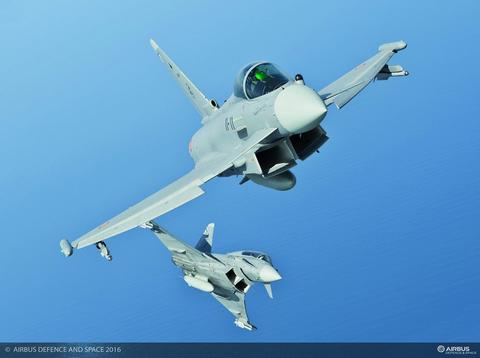
Eurofighters of the Spanish Air Force.
Teaming for the Future Combat Air System
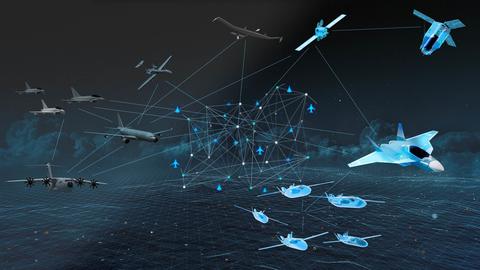
In 2018, Airbus joined with France’s Dassault Aviation in a landmark agreement to develop and produce Europe’s Future Combat Air System (FCAS), which is slated to complement – and eventually replace – the current generation Eurofighter Typhoon and French-built Rafale fighter aircraft between 2035 and 2040.
Hailed as a landmark industrial agreement for Europe, the FCAS is envisioned as a “system of systems” – composed of elements connected and operating together that include a next-generation fighter aircraft, medium-altitude long-endurance unmanned aerial vehicles, future cruise missiles and drones flying in swarms, along with military services’ existing fleets of combat aircraft.
The FCAS programme will build on the current cooperation of Airbus and Dassault for the European Medium-Altitude Long-Endurance Remotely Piloted Aircraft (MALE RPAS), which also involves the participation of Italy’s Leonardo. FCAS could be widened to the involvement of other key European players.

